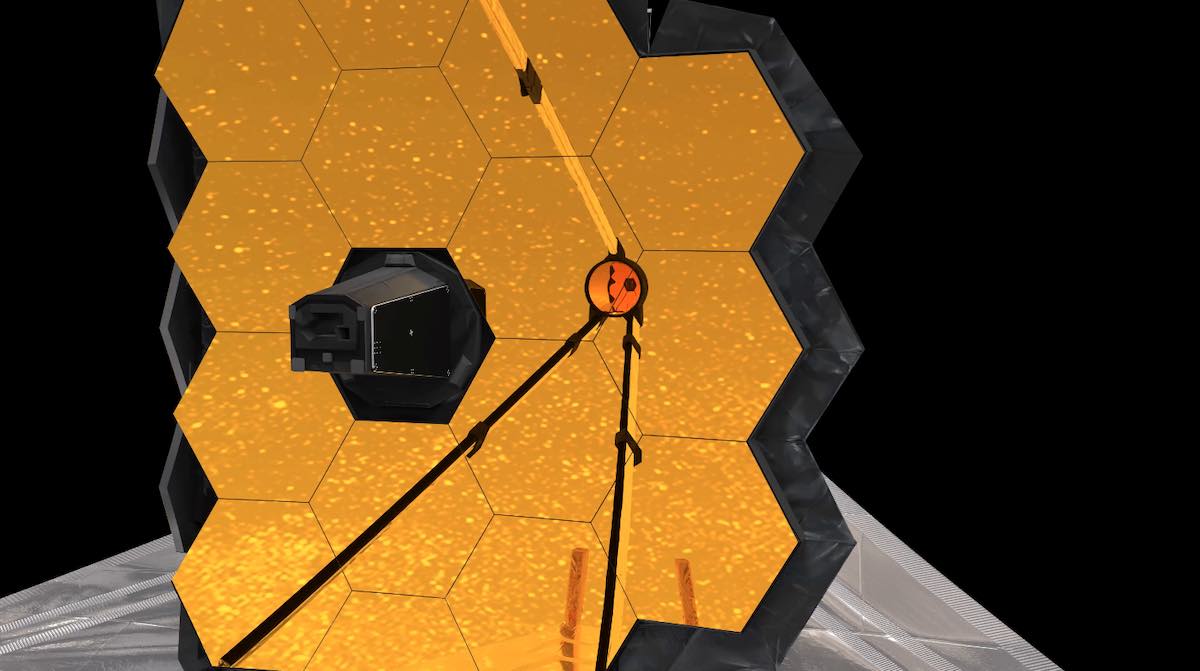
One of the two wings holding three of the James Webb Space Telescope’s gold-coated mirror segments folded into place Friday, setting the stage for positioning of the other wing Saturday to complete the nearly $10 billion observatory’s major deployments.
“Webb’s iconic primary mirror is taking its final shape,” NASA said in a blog post Friday. “Today, the first of two primary mirror wings, or side panels, was deployed and latched successfully.”
The primary mirror consists of 18 hexagonal beryllium mirror segments, each 4.3 feet (1.3 meters) in width, precisely polished to specifications for operations at super-cold, cryogenic temperatures. The mirrors are covered in a thin coating of gold, which is highly reflective of infrared light, the section of the spectrum Webb is tuned to see.
The 18 mirror segments are coated with about a tenth of a pound (48 grams) of pure gold, about the mass of a golf ball.
Twelve of the mirror segments are mounted on the central section of the telescope. Two wings, each with three mirror segments, were folded up on each side for launch, allowing Webb to fit inside the payload shroud of its Ariane 5 rocket.
The process to deploy the port, or left-side, wing began at 8:36 a.m. EST (1336 GMT) Friday, according to NASA.
The first step of Friday’s work involved releasing restraint mechanisms that kept the port wing folded back for launch.
The panel then rotated forward on hinges, moving into position next to the center section of the telescope. The motor-driven move was expected to take about five minutes, NASA said. Then mission controllers at the Space Telescope Science Institute in Baltimore, who commanded the operation, took steps over several hours to latch the mirror wing into place.
The work was completed at 2:11 p.m. EST (1911 GMT) Friday, NASA said.
“First wing of the telescope mirror is deployed and latched!” tweeted Heidi Hammel, an astronomer on the Webb mission, and the vice president for science at the Association of Universities for Research in Astronomy. “We are one step away for all major structural deployments being completed.”
Webb’s starboard, or right-side mirror wing will follow a similar procedure Saturday, completing the last of the mission’s critical post-launch deployments. With that milestone, the primary mirror will extend 21.3 feet (6.5 meters) in diameter, making Webb the largest telescope ever sent into space.
The mirror deployments mark the final step in a busy two weeks of work to transform Webb from its launch configuration, when it was folded up like an origami inside the Ariane 5 payload fairing, into a working space telescope.
Webb deployed its solar panel moments after separating from its launcher, and then folded open a high-gain antenna to improve communications with ground teams on Earth.
The observatory then deployed two large pallet structures containing the mission’s sunshield, a thermal barrier designed to keep Webb’s mirrors and science instruments at super-cold temperatures, nearly minus 400 degrees Fahrenheit.
On New Year’s Eve, controllers uplinked commands for Webb to extend two booms from each side of the spacecraft. The booms pulled out the five-layer sunshield like a blanket until it reached its full size, roughly equivalent to the area of a tennis court. The deployment plunged the telescope’s mirrors into permanent darkness, allowing temperatures to begin dropping down to Webb’s operating conditions.
On Monday and Tuesday, ground teams monitored the careful tensioning of all five layers of the sunshield. Each membrane, as thin as a human hair, is made of kapton and treated with aluminum to reflect heat.
Webb’s secondary mirror support structure deployed on a tripod-like apparatus Wednesday, and a radiator opened on the back side of the observatory’s instrument module Thursday, clearing the way for the final primary mirror wing deployments Friday and Saturday.
Email the author.
Follow Stephen Clark on Twitter: @StephenClark1.
from Spaceflight Now https://ift.tt/3q5HHNh
via World Space Info







0 comments:
Post a Comment